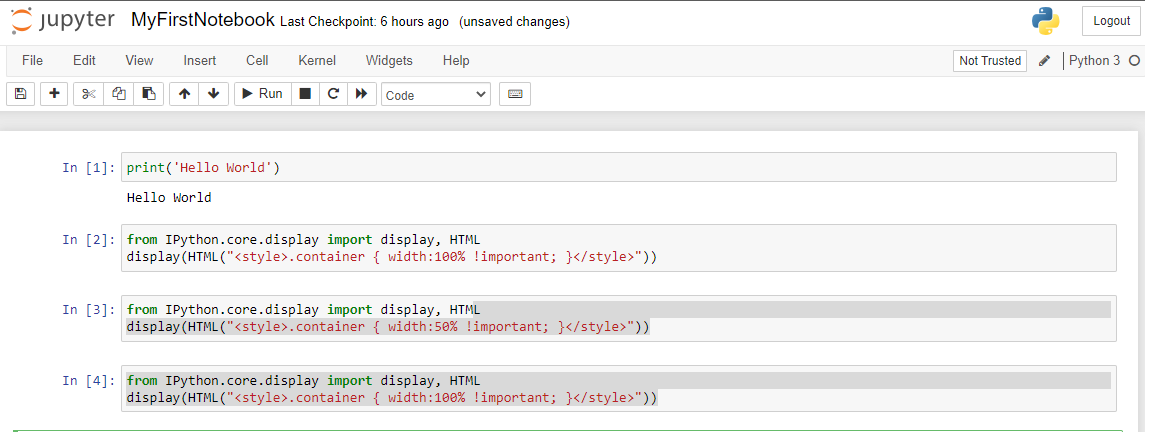

- HOW TO RUN JUPYTER NOTEBOOK ON WINDOWS HOW TO
- HOW TO RUN JUPYTER NOTEBOOK ON WINDOWS INSTALL
- HOW TO RUN JUPYTER NOTEBOOK ON WINDOWS CODE
- HOW TO RUN JUPYTER NOTEBOOK ON WINDOWS DOWNLOAD
- HOW TO RUN JUPYTER NOTEBOOK ON WINDOWS WINDOWS
HOW TO RUN JUPYTER NOTEBOOK ON WINDOWS CODE
From within a Python language notebook, you can inject your SAS program code and pull in SAS results. These magic commands look almost just like SAS macro calls (imagine that!).

The second way that you can run SAS code is by using special Jupyter "magics" supported by the sas_kernel.

nbextensions/showSASLog) that can show you the SAS log. The most natural method is to create a new SAS notebook, available from the New menu in the Jupyter Home window and from the File menu in an active notebook:įrom a SAS notebook, you can enter and run SAS code directly from a cell: Within Jupyter, the sas_kernel provides multiple ways to access SAS programming methods. Visit the project on GitHub: sas_kernel by sassoftware If you want to learn more about Jupyter and see the SAS support in action, then you can watch the video here. My colleague Amy Peters announced this during a SAS Tech Talk show at SAS Global Forum 2016. With this new project on the /sassoftware page, SAS contributes new support for running SAS from within Jupyter Notebooks - a popular browser-based environment used by professors and data scientists. In the middle of the page, in the Jupyter notebook tile, click Ī Jupyter file browser will open in a web browser tab.We've just celebrated Earth Day, but I'm here to talk about Jupyter - and the SAS open source project that opens the door for more learning.
HOW TO RUN JUPYTER NOTEBOOK ON WINDOWS WINDOWS
Open Anaconda Navigator using the Windows start menu and select ->. Anaconda Navigator comes with the Anaconda distribution of Python. One additional way to open a Jupyter notebook is to use Anaconda Navigator. This web browser page is a Jupyter notebook. You will see a new tab open in your web browser. If a web browser doesn't open automatically, you can copy the web address from the Anaconda Prompt and paste it into a web browser's address bar.

Ī web browser should open, and you should be able to see the Jupyter file browser. The output in the Anaconda Prompt will look something like the output shown below:Ĭopy/paste this URL into your browser when you connect. This command starts the Jupyter notebook server. The Anaconda Prompt window should look something like the image below.Īt the Anaconda Prompt type: > jupyter notebook
HOW TO RUN JUPYTER NOTEBOOK ON WINDOWS DOWNLOAD
Download Anaconda at the following link: /distribution
HOW TO RUN JUPYTER NOTEBOOK ON WINDOWS INSTALL
If you don't see the Anaconda Prompt in the Windows Start Menu, then you need to install the Anaconda distribution of Python. Go to the Windows start menu and select under. Then click the run button in the middle of the menu at the top of the notebook.Īnother method to open a Jupyter notebook is to use the Anaconda Prompt. Try typing the code below in the first cell in the notebook to the right of the In : prompt: import this In the upper right select -> Ī new notebook will open as a new tab in your web browser. This action opens the Jupyter file browser in a web browser tab. Open the Windows start menu and select -> Note that the Anaconda distribution of Python must be installed to use the Windows Start Menu to open a Jupyter notebook. One way to open a Jupyter notebook is to use the Windows Start Menu. On Windows, a Jupyter notebook can be started from the Anaconda Prompt, the Windows start menu and Anaconda Navigator. Jupyter notebooks contain Python code, the output that code produces and markdown cells usually used to explain what the code means. One way problem solvers can write and execute Python code is in Jupyter notebooks.
HOW TO RUN JUPYTER NOTEBOOK ON WINDOWS HOW TO
In this section, you will learn how to open a Jupyter notebook on Windows and MacOS. Opening a Jupyter Notebook Opening a Jupyter Notebook Problem Solving with Python Book Construction Open a Jupyter Notebook with Anaconda Navigator Open a Jupyter Notebook with the Anaconda Prompt Open a Jupyter notebook with the Windows Start Menu


 0 kommentar(er)
0 kommentar(er)
